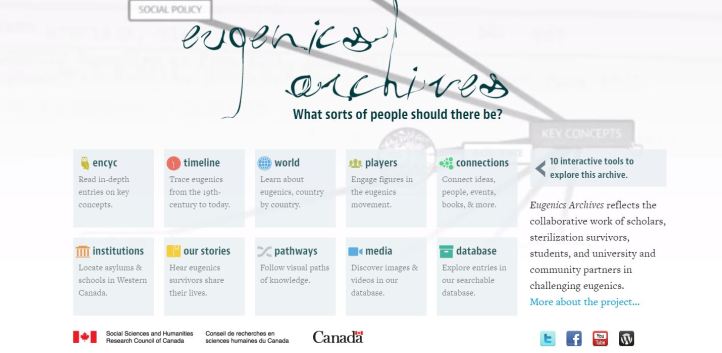First Nations Canada: Eugenics

Seven facts about eugenics in Canada
- Of the more than 3000 eugenic sterilizations in Canada, the vast majority were performed in Alberta under the direction of a Eugenics Board.
- While eugenic sterilization waned across the world following the end of the Second World War in 1945, Alberta’s sterilization program continued until the repeal of the Sexual Sterilization Act of Alberta in 1972.
- Leilani Muir won a landmark lawsuit against the province of Alberta in 1996 for wrongful confinement and sterilization; two documentaries, The Sterilization of Leilani Muir (1996) and Surviving Eugenics (2015) engage general audiences with issues that the case and its aftermath raise, and their significance for Canadians today.
- The explicit or implicit grounds for eugenic sterilization were typically that a person’s undesirable mental or physical disabilities were thought to be heritable, and that such a person was thus unsuitable to parent.
- Although central amongst those targeted by eugenic practices were people with a variety of disabilities, many children institutionalized, sterilized, and otherwise subject to eugenic practices in Canada did not in fact have disabilities.
- Members of other marginalized groups–single mothers, First Nations and Métis people, eastern Europeans, and poor people—were disproportionately represented amongst those subjected to eugenic ideas and practices, such as sterilization.
- The legacy of eugenics, expressed in sterilization laws and in social policies concerning immigration, schooling, and prenatal screening, remains with us today.
MEGWETCH THANK YOU
HUGE Thank you for visiting this blog and sharing this with your kin. It's appreciated. Contact Trace anytime! Use the form below.
BOOKSHOP
Please use
BOOKSHOP to buy our titles. We will not be posting links to Amazon.
Popular Posts
-
White Earth Nation welcomes adoptees home by Dan Gunderson , Minnesota Public Radio October 5, 2007 Listen to feature audio This weekend th...
-
2023 Editor NOTE: This is one of our most popular posts so we are reblogging it. (SEE COMMENTS) If you do know where Michael Schwartz is, pl...
-
I could on for an hour about this but I won't. Fathers have rights and this time, a father got his daughter back after a...
-
You know everything happens for a reason. I just received the book “Sudden Fury” about an adoptee who killed his adoptive parents in Marylan...
-
Boston Globe June 2, 1996 REUNION DAY AT 43: NAVAJO NATIVE FINALLY HOME Author: Royal Ford, G...
-
T he Métis National Council and the Government of Canada will be working collaboratively, Nation-to-Nation, to develop a process to engag...
-
CLICK: AMERICAN INDIAN ADOPTEES: GUEST POST: Reactive Attachment Disorder by Levi E... : Levi EagleFeather (Lakota) This is one of the most...
To Veronica Brown
Veronica, we adult adoptees are thinking of you today and every day. We will be here when you need us. Your journey in the adopted life has begun, nothing can revoke that now, the damage cannot be undone. Be courageous, you have what no adoptee before you has had; a strong group of adult adoptees who know your story, who are behind you and will always be so.







No comments:
Post a Comment
Please leave a comment.